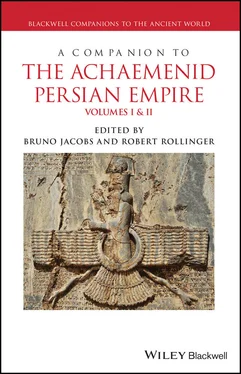Section VII(Society and Politics: Chapters 70– 78) is concerned with another structural aspect, namely the sociohistorical dimension. It unfolds the social makeup of the empire, with its wide reach from slave to Great King. Because of the source situation, the imperial centers with their residences, courts, and court life feature heavily in this context. Since the satraps in the empire's provinces tended to mirror and imitate the Great Kings' attitudes and actions, this chapter reveals an imperial dimension as well. It describes places and techniques of imperial politics, such as banqueting and gift exchange, and highlights how the king and his court dealt with diplomacy and jurisdiction. Royal enactments were staged and performed in a ceremonial setting in which clothes and insignia played an important role. But it is not only the official aspects of monarchic rule that are taken into account; attention is also paid to the Great Kings' leisure activities, among which hunting wild game loomed especially large. Finally, as in all societies throughout world history, sex and gender are an integral part of social life that have to be given appropriate consideration.
Section VIII. (The Persian Empire at War: Chapters 79– 82) investigates the military dimension. It goes without saying that the empire was the major military superpower of its time. Its ability to mobilize armies with manpower from all over its territory was more than impressive. Moreover, it was the first Near Eastern empire to build up a navy as an independent force that matched the quality and strength of its vast ground forces. All of this comes through in Greek reports of the so‐called Persian Wars, although, ironically, these accounts do not explicitly highlight the empire's organizational and infrastructural strength in mounting a campaign by a combined land and naval force at its outmost western fringes, but instead accentuate the Great Kings' hubris and arrogance. However, Chapters 79– 82do not focus only on the organizational skills of the empire in raising and recruiting vast armies; they also investigate ideology and the specific ways in which the empire and its kings legitimated the imperial war machine.
Section IX(Religion and Worship: Chapters 83– 88) deals with cult and belief in the empire. This is a subject with many facets and the six contributions cover a wide range of topics. The section is one in which dissent within modern scholarship looms particularly large. We have made a conscious choice not to harmonize these different voices and opinions but to make plain the diversity of conceptions and reconstructions found in modern research. In this way the reader can get a proper flavor of the controversies surrounding the religion of Achaemenid rulers and their elites, and of the question as to whether their belief system may be described as Zoroastrianism, Mazdaism, or neither. The section also develops a broader perspective, however, by focusing on funerary customs as well as on the diverse practices of worship encountered both within the empire's heartland and across its various regions.
Section X(“ Geistesgeschichte ,” Science, and Technology: Chapters 89– 93) pinpoints intellectual movements, education, and learning, as well as science and techniques. In doing so it touches on a variety of topics. Contributions on Astronomy and Astrology, Physicians and Medicine, and Techniques of Art and Architecture (Chapters 90, 92 and 93) deal with the empire's hard sciences. School, Erudition, and Wisdom ( Chapter 89) focuses on the empire's educational system, while the provocatively titled contribution on Persian “Enlightenment” ( Chapter 91) draws attention to intellectual accomplishments within the empire that are commonly ascribed only to its western neighbors.
Section XI(The Perspective of Art: Chapters 94– 96) introduces the major categories of artistic production in the empire. Alongside statuary, relief sculpture, and minor arts, this includes poetry, music, and dance.
The last two extensive sections of the Companion focus in an innovative way on the empire's Nachleben . This is not just an appendix but a substantive part of the book in its own right, and it demonstrates clearly that the empire survived its downfall. Section XII(Reception and Heritage: Chapters 97– 105) is divided into the three subsections: A Modes of Perception, B The Local Heritage, and C Contemporary Perception. Its nine contributions guide the reader through the empire's reception history, starting with Classical Antiquity and ending with the Popular Culture of our own times. Section XIII(History of Research: Chapters 106– 110) concludes the Companion with a balanced overview of the ways in which the empire has been investigated by researchers from the major regions of the scientific world and highlights the principal trajectories and Leitfragen of this research through the past 100 years and more.
It will be no surprise that this Companion has quite a long history of its own. From its very beginning, with the initial conceptualization of the project and the first contacts with the publishing house in Berlin in August 2009, through the invitations to contributors and the gathering and editing of the papers, and then on to the eventual publication of the volume, many years have gone by. As always, the editors planned to finish their work much earlier than actually turned out to be possible. There were many reasons for this. On the one hand, the Companion set itself ambitious goals. It was our aim not just to publish a further volume on the Achaemenid Persian Empire but to present an up‐to‐date overview of recent research that included a broad set of topics that had not previously been dealt with in such a comprehensive manner. This is especially true for the chapters on archeological research as well as for those on reception history and history of research. Many contributions to the Companion are therefore not just summaries but the results of very recent research agendas in their own right. On the other hand, the sheer number of contributions (110 in total) created problems of its own that had to be tackled and solved by the editors. But in the end we have made it, and we very much hope that we have been successful in presenting an overview of a kind that has never been available before.
Finally, it is our pleasure to express our gratitude to those people and colleagues without whose help the Companion would not have been possible. This, of course, applies first and foremost to the 83 authors who contributed to the volume. Their competence and forbearance were essential for the result. There are also the various colleagues from the publishing house, whose friendly guidance and assistance we always enjoyed and appreciated. The editors' special thanks go to the editorial assistants at the Institut für Alte Geschichte und Altorientalistik, Universität Innsbruck, whose skill and patience made a huge contribution to the success of the editorial work: Manuel Pohl, Matthias Hoernes, Katharina Reinstadler, Sabrina Buchebner, Dolores Dollnig, Julian Degen, Florian Posselt and Clemens Steinwender. They would not have been available, of course, without generous financial assistance from the University of Innsbruck, and especially the Dean of the Historisch‐Philologische Fakultät, Prof. Dr. Klaus Eisterer. Dankeschön! Very special thanks also go to Carmen Marcks‐Jacobs, who adapted several plans and maps for publication in the present work. There is a German proverb that may accurately describe the long and often strenuous editorial process of this Companion : “Gut Ding will Weile haben.” We hope that this also applies to the present publication.
The authors are grateful to Christopher Tuplin for his assistance with the English version of this text.
Читать дальше












